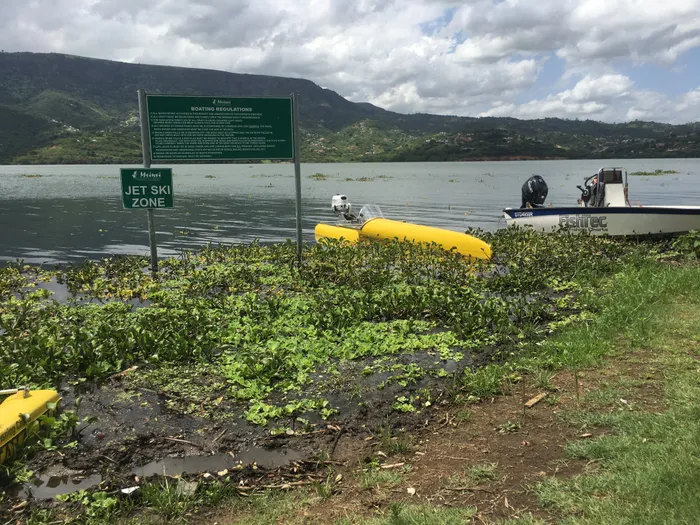Effects of water hyacinth in Inanda Dam

Water hyacinth at Inanda Dam in Durban has affected water activities, stakeholders, amakhosi as well as the community at large. Picture: Nomonde Zondi
Durban — The local users, community members and stakeholders in Inanda Dam and Resort have asked Umgeni Water and the Department of Forestry, Fisheries and the Environment (DFFE) to communicate effectively on the developments and plans that they have to solve the water hyacinth problem in the dam.
This issue is one that has affected stakeholders immensely, especially water sports enthusiasts, amakhosi, as well as the community at large because of an increase in the death of livestock and gardens or fields.
On Monday, the managing director of Msinsi Holdings, which is tasked with managing the water resources around Umgeni Water-owned or managed dams, Mbali Ndlovu, claimed that the removal of the boom gate on bridge four could be one of the causes of the water hyacinth.
Ndlovu said Monday’s meeting allowed stakeholders an opportunity to address the matter and discuss possible solutions that will be implemented to combat the problem.

Ken Ground, the chairperson of Major Bass, which often hosts fishing competitions at the dam, said they had decided to no longer come to the dam until the water hyacinth issue had been resolved. He said he could not understand why this was not resolved in winter because it was the best time to solve this problem.
Ground said they had to cancel their plans for the year because of water hyacinth.
KwaZulu-Natal regional manager of DFFE, Ryan Brudvig admitted that they are at fault for relying on one method to solve the water hyacinth problem.
Brudvig said; “In the past there would be a helicopter to spray over the area twice a year. We cannot rely on just biological control. One method is not going to work and that is where we have gone wrong.”
Brudvig said that various solutions were needed, however, the main concern was that the water quality was going to deteriorate with chemical spray. Brudvig said there was a budget to solve issues like the water hyacinth in the dam.

A Google search revealed that hyacinth is quite easily the most damaging water invader in South Africa. First introduced into the Cape area in the early 1900s, the plant has spread aggressively, choking waterways of nutrients and life forms wherever it grows.
Daily News
Related Topics: